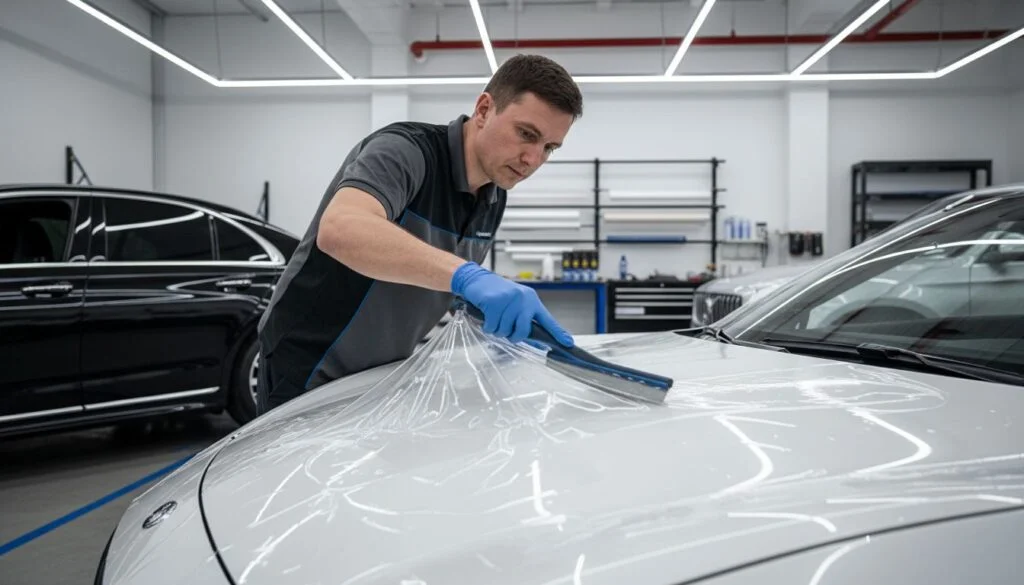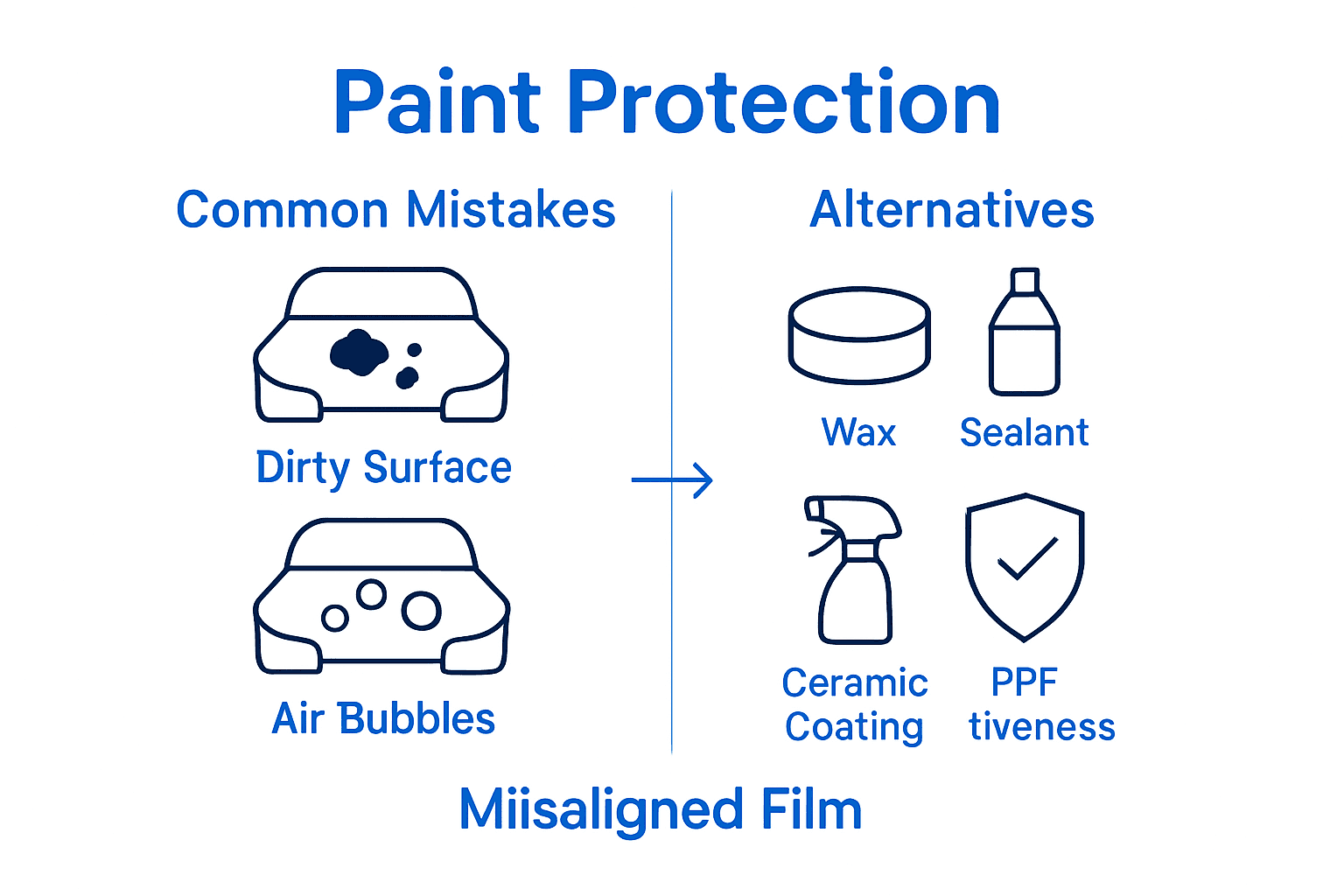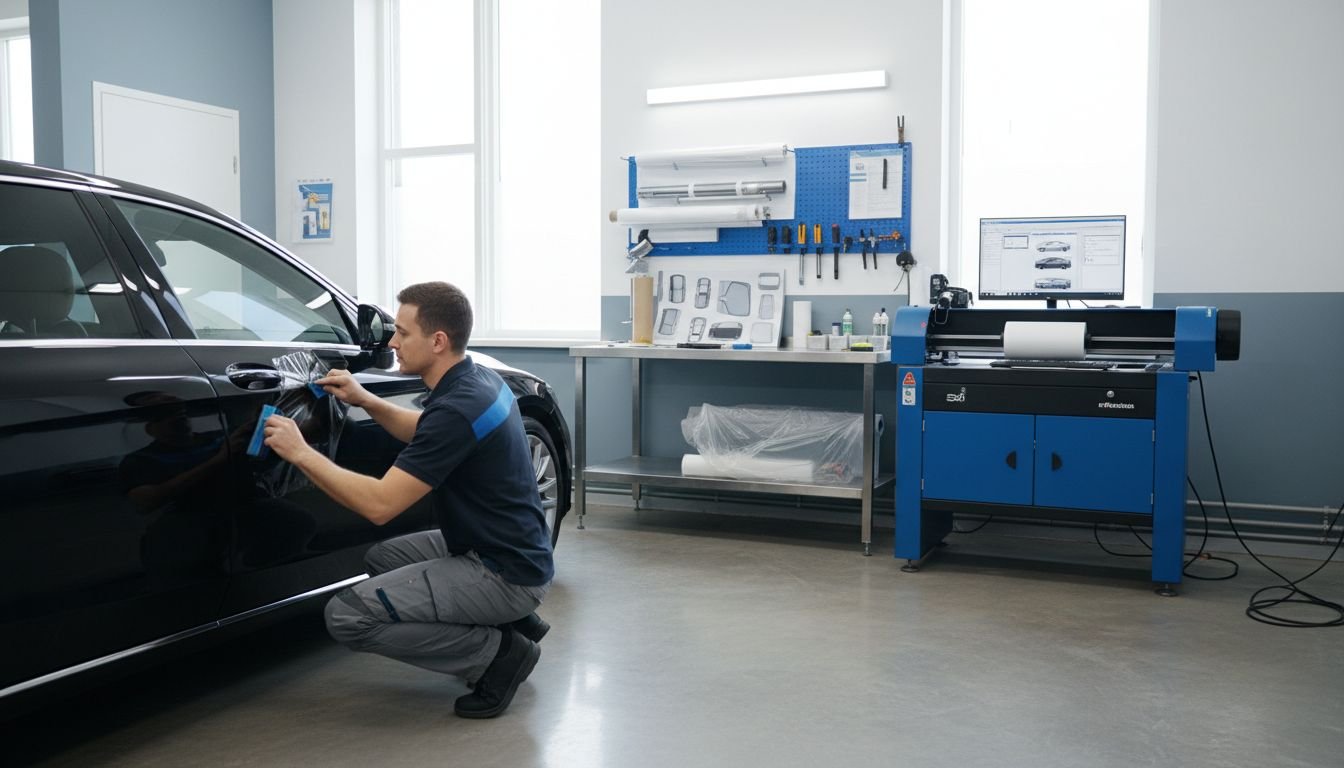
Over 80 percent of new car owners worry about losing that showroom shine within the first year. Unforgiving sunlight, road debris, and acid rain can dull and damage your vehicle’s finish far sooner than you expect. Protecting your investment takes more than just an occasional wash. This guide unpacks modern paint protection solutions, revealing practical methods to help you keep your car looking newer for longer.
Table of Contents
- Defining New Car Paint Protection
- Types of Paint Protection Solutions
- How Paint Protection Film Works
- Key Steps in Professional Installation
- Common Mistakes and Alternatives Compared
Key Takeaways
| Point | Details |
|---|---|
| Comprehensive Protection | New car paint protection techniques defend against environmental damage and enhance aesthetic appeal through methods like PPF and ceramic coatings. |
| Advanced Applications | The latest protective solutions utilize sophisticated materials and installation techniques for optimal durability and effectiveness. |
| Crucial Installation Steps | Proper surface preparation and precise application are vital to ensuring the performance of paint protection solutions like PPF. |
| Consider Alternatives | Professionals should assess various protective strategies, balancing cost, durability, and vehicle-specific needs for the best outcomes. |
Defining New Car Paint Protection
Paint protection is a strategic automotive preservation technique designed to shield a vehicle’s exterior finish from environmental damage and wear. According to Wikipedia, paint protection film (PPF) is a thermoplastic urethane film applied to painted surfaces of new or used cars to protect against stone chips, bug splatters, and minor abrasions.
The primary goal of new car paint protection is comprehensive surface preservation. This involves defending the vehicle’s exterior against multiple potential damage sources, including ultraviolet rays, acid rain, road debris, and environmental contaminants. As Wikipedia highlights, paint sealants can protect car finishes and enhance their aesthetic shine, offering both functional and visual benefits.
Key elements of automotive paint protection encompass multiple defensive strategies:
- Physical barrier films that shield against direct surface impacts
- Chemical sealants preventing oxidation and environmental degradation
- Transparent protective coatings maintaining original paint appearance
- Preventative maintenance techniques to extend paint longevity
Modern paint protection solutions have evolved significantly, transitioning from traditional waxing methods to advanced technological interventions like PPF versus Ceramic Coating that offer professional-grade protection for automotive enthusiasts and detailing specialists.
Types of Paint Protection Solutions
Automotive professionals have several strategic options for protecting vehicle paintwork, with each solution offering unique advantages. According to Wikipedia, paint protection film (PPF) represents a premier technological solution, utilizing thermoplastic urethane applied directly to painted surfaces to defend against stone chips, bug splatters, and minor abrasions.
The primary paint protection solutions professionals utilise include:
- Paint Protection Film (PPF): A transparent film providing comprehensive surface protection
- Ceramic Coatings: Liquid polymer treatments creating a nano-ceramic shield
- Synthetic Sealants: Chemical treatments offering UV and environmental resistance
- Carnauba Wax: Traditional organic protection method with aesthetic enhancement
As Wikipedia highlights, paint sealants serve critical functions by protecting car finishes from ultraviolet rays and acid rain while simultaneously enhancing visual shine. Professional detailers increasingly prefer advanced solutions like top paint protection film benefits that offer comprehensive, long-lasting protection.
Moreover, modern paint protection technologies have dramatically evolved from traditional waxing techniques. Professionals now leverage sophisticated materials engineered to provide microscopic-level defense, ensuring vehicles maintain pristine appearances while resisting environmental degradation. The selection of protection method depends on specific client needs, vehicle usage, and desired longevity of the protective treatment.

How Paint Protection Film Works
Paint protection film (PPF) represents a sophisticated defensive technology designed to shield automotive surfaces from environmental and physical damage. According to Wikipedia, PPF is a thermoplastic urethane film applied directly to painted surfaces, specifically engineered to protect against stone chips, bug splatters, and minor abrasions.
The application process of PPF focuses on strategic coverage of high-impact vehicle areas. As research indicates, manufacturers typically apply film to critical zones such as:
- Hood: Primary impact zone for road debris
- Front Fenders: Susceptible to stone chip damage
- Front Bumper: Highest exposure to potential surface impacts
- Side View Mirrors: Vulnerable to environmental contaminants
- Rocker Panels: Lower body protection against road grime
- Lower Door Sections: Shield against mud and debris splashes
- Rear Guards: Protect wheel arch areas from potential damage
Professionals understand that PPF operates through a multilayered protective mechanism. The film’s advanced thermoplastic urethane composition allows it to absorb impacts, self-heal minor scratches, and provide a virtually invisible protective barrier. When understanding PPF installation techniques, technicians recognize the importance of precise application to maximize the film’s protective capabilities.
Modern PPF technologies have evolved to offer remarkable protective properties. The film’s molecular structure enables it to resist UV degradation, maintain clarity, and provide a sacrificial layer that preserves the underlying paint finish. Professional installers leverage these advanced materials to deliver comprehensive surface protection that extends far beyond traditional waxing or temporary protective measures.
Key Steps in Professional Installation
Professional paint protection film (PPF) installation requires meticulous preparation, precision, and technical expertise to ensure optimal vehicle surface protection. According to Wikipedia, manufacturers strategically apply PPF to high-impact vehicle areas, establishing a blueprint for professional installers to follow.
The comprehensive PPF installation process involves several critical stages:
- Surface Preparation
- Thorough deep cleaning of vehicle surface
- Complete decontamination and paint correction
- Removing existing waxes, sealants, and surface impurities
- Measurement and Pattern Selection
- Precise vehicle surface measurements
- Selecting appropriate film coverage areas
- Utilizing advanced cutting templates for accuracy
- Film Application Techniques
- Carefully positioning protective film
- Using professional-grade squeegees and application tools
- Ensuring seamless, bubble-free installation
- Final Inspection and Quality Control
- Checking film alignment and coverage
- Verifying edge adhesion and smoothness
- Conducting comprehensive visual and tactile assessments
Professional installers recognize that successful PPF application goes beyond technical skills. When training new installers using advanced tutorials, emphasis must be placed on understanding both the technical and artistic aspects of film installation.
Ultimately, professional PPF installation is a sophisticated process that combines technical precision with expert craftsmanship. Successful installers invest in continuous learning, advanced tools, and stay updated with the latest film technologies to deliver exceptional protective solutions for vehicle owners.
Common Mistakes and Alternatives Compared
Professional vehicle protection requires a nuanced understanding of various protective technologies and potential pitfalls. According to Wikipedia, paint protection film is a thermoplastic urethane solution approved by manufacturers to defend against stone chips, bug splatters, and minor abrasions.
Common mistakes professionals encounter during paint protection include:
Inadequate Surface Preparation
- Skipping comprehensive vehicle cleaning
- Failing to remove existing contaminants
- Rushing the initial surface preparation stage
Improper Film Application
- Introducing air bubbles during installation
- Misaligning protective film edges
- Using incorrect application techniques
Material Selection Errors
- Choosing low-quality protective films
- Neglecting specific vehicle surface requirements
- Inappropriate film thickness for intended use
Alternative protection methods offer varying levels of defense. Wikipedia highlights that paint sealants provide protection from ultraviolet rays and acid rain, presenting an alternative to full PPF coverage. Professional installers can explore comparing paint protection strategies to determine the most appropriate solution for specific client needs.
Successful automotive surface protection demands a comprehensive approach. Professionals must carefully evaluate each protection method’s strengths and limitations, considering factors like durability, cost-effectiveness, and specific environmental challenges. The key lies in matching the right protective technology to the unique requirements of each vehicle and its intended use.

Elevate Your New Car Paint Protection with Precision Cutting Solutions
Protecting your vehicle’s finish with the right paint protection film starts with flawless application. The article highlights common challenges installers face such as avoiding bubbles, misalignment, and material waste. If you are passionate about delivering professional-grade protection, you understand how vital exact pattern cuts and surface preparation are to ensure a seamless, durable barrier. Precision and efficiency are not just goals but necessities to preserve the pristine appearance of your client’s new car.
Unlock the potential of your installation skills by using the Paint Protection Film – AEONCUT PPF Pre-cut Cutting software which offers an extensive library of precise, pre-cut patterns for a variety of vehicle models.

Don’t let guesswork or material waste hinder your success. Harness AEONCUT’s advanced software technology at aeoncutsw.com to deliver unmatched accuracy and speed. Designed for both professional installers and car enthusiasts, this platform ensures your paint protection film fits flawlessly every time. Explore our Featured – AEONCUT PPF Pre-cut Cutting software for the latest innovations and join the future of automotive surface protection today.
Frequently Asked Questions
What is paint protection film (PPF) and how does it work?
Paint protection film (PPF) is a thermoplastic urethane film applied to a vehicle’s painted surfaces to protect against stone chips, bug splatters, and minor abrasions. It acts as a physical barrier that absorbs impacts and self-heals minor scratches, maintaining the vehicle’s original paint appearance.
What are the benefits of using ceramic coatings for paint protection?
Ceramic coatings provide a nano-ceramic shield that protects against UV rays, acid rain, and environmental contaminants. They enhance the vehicle’s shine and make it easier to clean while offering long-lasting durability compared to traditional waxing methods.
What are the common mistakes made during paint protection installation?
Common mistakes include inadequate surface preparation, such as failing to clean or decontaminate the vehicle properly, improper film application that may cause air bubbles, and incorrect material selection that doesn’t match the vehicle’s needs or intended use.
How does paint protection compare to traditional waxing?
Paint protection solutions like PPF and ceramic coatings offer more advanced, long-lasting protection compared to traditional waxing. While waxing can enhance shine, it doesn’t provide the same level of defense against environmental damage or physical wear as PPF or ceramic coatings.
Recommended
- How Does PPF Work? Guide for Car Care Pros 2025 – AEONCUT PPF Pre-cut Cutting software
- Top Paint Protection Film Benefits for Auto Professionals 2025 – AEONCUT PPF Pre-cut Cutting software
- PPF Versus Ceramic Coating: Best Choice for Automotive Pros 2025 – AEONCUT PPF Pre-cut Cutting software
- Clear Bra vs PPF: Key Differences for Detailing Pros 2025 – AEONCUT PPF Pre-cut Cutting software


